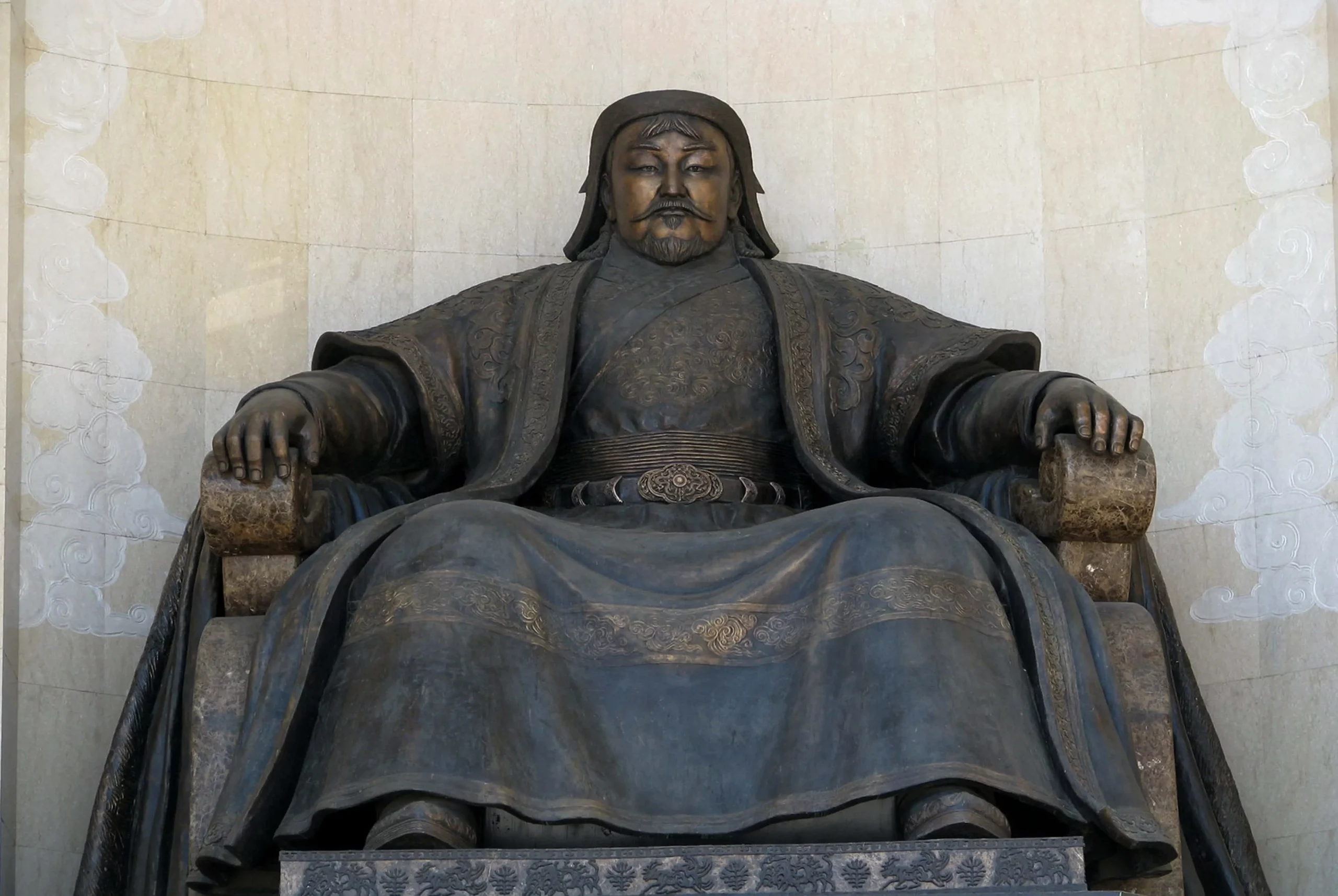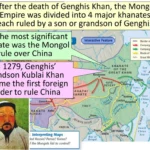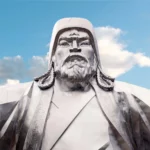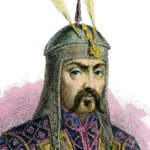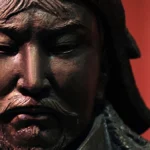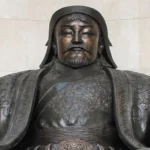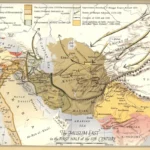Get ready for an epic adventure through the mighty Genghis Khan’s empire! It’s a story of conquering warriors and a lasting legacy that shaped our world forever. As a history buff, I’ve dug deep into the ancient scrolls and pieced together the thrilling tale of this formidable empire. Prepare to witness the rise and fall of a military superpower that left an unforgettable imprint on history.
The Mighty Empire of Genghis Khan
Imagine yourself in a world where one man’s ambition reshaped history. That’s the story of Genghis Khan, the legendary ruler who founded an empire that spanned from Asia to Europe.
Rise to the Top
Genghis Khan wasn’t born a leader. He started out as just another dude named Temüjin, but through his cunning and military genius, he united the scattered tribes of the Asian steppes. His army was like lightning, swift and deadly, thanks to their lightning-fast cavalry. With every conquest, the empire grew bigger and stronger.
The Mongol Colossus
At its peak, Genghis Khan’s empire stretched so far that you could barely imagine it. It covered parts of China, Russia, the Middle East, and even reached the gates of Europe. It was a world power that forever changed the course of history.
The Legacy of a Conqueror
More than just a conqueror, Genghis Khan was also a visionary. He built a massive network of trade routes linking East and West, allowing different cultures to share ideas and goods. Under his rule, different religions were tolerated, creating a melting pot of beliefs.
Impact on Civilization
The Mongol Empire was a catalyst for progress. It introduced new technologies like gunpowder and paper, and played a key role in spreading knowledge from China to Europe. Genghis Khan’s legacy lives on, not only as a symbol of military might but also as a reminder of how one person’s ambition can shape the world.
Delve into the fascinating Genghis Khan biography and uncover the life and conquests of this legendary conqueror who shaped the course of history. Learn about the innovative Genghis Khan military tactics that enabled him to establish one of the largest empires the world has ever seen. Explore the impact of Genghis Khan’s history and its lasting legacy on the world stage. Finally, unravel the fascinating story of Genghis Khan’s legacy and discover how his influence continues to shape our understanding of leadership and conquest.
What were the key military strategies and tactics that enabled the Genghis Khan Empire to conquer vast territories?
Imagine a group of warriors galloping across vast landscapes, their arrows flying like a swarm of bees, their horses like extensions of themselves. This was the Mongol Empire, a force that swept through Asia and Europe like a storm, conquering vast territories with astonishing speed and efficiency.
Their military prowess was no accident. The Mongols had developed a winning formula, a deadly combination of tactics and strategies that made them virtually unstoppable on the battlefield. Let’s dive into their secrets:
Lightning-Fast Cavalry: The Cavalry That Conquered Continents
The Mongols were masters of cavalry warfare. Their horses were tough and agile, carrying them over rough terrains and long distances with ease. Their saddles were designed for speed and maneuverability, allowing them to make sharp turns and launch surprise attacks.
But speed was not their only weapon. Mongol cavalrymen were also skilled archers, firing their arrows with incredible accuracy from horseback. They could rain down a barrage of arrows on their enemies, decimating their ranks before they could even react.
Agile Tactics: Adapting to the Enemy and Landscape
The Mongols were not a one-trick pony. They were strategic geniuses who adapted their tactics to suit the enemy and the terrain they faced.
When besieging cities, they used siege weapons to break through fortifications and employed psychological warfare to demoralize their opponents. In open battle, they would form a crescent-shaped formation, enveloping the enemy and cutting off their escape routes.
And if all else failed, they would resort to scorched-earth tactics, destroying everything in their path to weaken their enemies and deny them resources.
Discipline and Unity: A Force United
The Mongol army was not just a collection of skilled warriors; it was a finely-tuned machine, operating with precision and unity. Discipline was paramount, with strict punishments for any who disobeyed orders.
Communication was also key. Mongol armies used a system of flags, drums, and messengers to relay commands and coordinate their movements across vast distances.
Innovation and Improvement: Embracing the Best of Their Enemies
The Mongols were not afraid to learn from their enemies. They adopted siege weapons and gunpowder from the Chinese, enhancing their arsenal. They also incorporated advanced communication techniques, such as utilizing smoke signals and relay stations, to stay connected on the battlefield.
A Legacy of Conquest: The Impact of Mongol Military Prowess
The Mongol Empire’s military prowess left an indelible mark on history. Their conquests spanned from Eastern Europe to the Pacific Ocean, creating one of the largest contiguous empires the world has ever seen.
The Mongols’ military strategies and tactics became a blueprint for future conquerors, influencing the development of warfare for centuries to come. Their legacy serves as a testament to the power of innovation, adaptation, and the unwavering spirit of a warrior nation.
How did the Genghis Khan Empire impact the political, social, and economic landscape of Eurasia?
The mighty Mongol Empire, forged under the leadership of Genghis Khan in the 13th century, left an enduring mark on the history and shape of Eurasia. Its impact reverberated far beyond the battlefield, transforming the political, social, and economic fabric of a vast region.
Political Landscape: A New World Order
Before the Mongol conquest, Eurasia was a mosaic of independent kingdoms and empires, each claiming a piece of the vast continent. But Genghis Khan’s relentless campaigns shattered this fragmented landscape, uniting these territories under a single banner. The result: the largest contiguous empire in human history.
This unprecedented political consolidation had profound consequences. Centralized governance, with Genghis Khan at the helm, streamlined administration and enforced uniform policies across the sprawling empire. New political structures, like the decimal system, fostered unity and efficiency. The balance of power shifted as once-mighty empires, like the Khwarezmid in Central Asia, crumbled before the Mongol onslaught.
Social Landscape: A Tapestry of Cultures
The Mongol Empire became a melting pot of diverse cultures, religions, and ethnicities. As the Mongol armies swept across Eurasia, they brought together people from distant lands, creating a vibrant exchange of ideas and practices.
Gunpowder, the game-changer from China, made its way westward through the Mongol network. Social mobility flourished as the Mongols adopted a merit-based system for selecting officials. This opened doors for individuals from all walks of life to climb the ranks of the empire. Notably, the Mongols embraced religious tolerance, allowing different faiths to coexist peacefully, fostering harmony and the spread of new spiritual ideas.
Economic Landscape: Trade and Prosperity
The Mongol Empire presided over a vast trade network that stretched from China to Europe. The Silk Road, a lifeline of commerce, was revitalized, enabling the flow of goods, technologies, and ideas across continents. This trade boom stimulated economic growth in regions along the Silk Road, enriching cities and facilitating the exchange of wealth and resources.
To facilitate trade, the Mongols introduced a standardized currency, the silver ingot. This unified monetary system stabilized the economy and made transactions easier and more efficient.
Legacy of Transformation
The Mongol Empire’s impact on Eurasia was transformative. It forged a new political landscape, fostering greater unity and interconnectedness. It promoted social mobility and cultural exchange, enriching the lives of people across the empire. And it revitalized the Silk Road, creating economic opportunities and fostering prosperity.
The legacy of the Genghis Khan Empire continues to resonate today, shaping the way we understand the history, culture, and economy of Eurasia.
What were the factors that contributed to the decline and eventual collapse of the Genghis Khan Empire?
The mighty Genghis Khan Empire, once a vast and powerful entity, eventually crumbled into ruin. Several factors played a pivotal role in its decline and collapse:
Fragmentation and Division
After Genghis Khan’s passing, his vast empire was divided among his sons like a giant puzzle. With each piece ruled by a separate khan, the empire lost its centralized authority and unity. This fragmentation weakened its military might and made it susceptible to attacks from rivals.
External Pressures
The Mongol Empire faced formidable threats from outside forces. The Black Death, a horrific plague, ravaged its population, leaving scars that never fully healed. Additionally, the rise of the Timurid Empire, under the formidable Timur, posed a significant challenge to Mongol dominance. Timur’s conquests weakened the Golden Horde, a crucial Mongol khanate in Eastern Europe.
Internal Conflict and Power Struggles
As the empire expanded rapidly, it became increasingly difficult to govern its vast territories. Regional leaders often clashed with each other, fueled by ambition and greed. Succession disputes further undermined the stability of the empire, as different factions fought for control.
Leadership Challenges
Genghis Khan’s death created a leadership void that his successors struggled to fill. Many rulers prioritized their own power and interests over the well-being of the empire. This lack of strong, visionary leadership contributed to its decline.
Military Exhaustion
The Mongol Empire’s relentless expansion had taken a heavy toll on its military resources. Constant warfare and maintaining a vast army drained its finances and manpower. Over time, the Mongols lost their military superiority and fell to their enemies.
Key Takeaways
- The empire’s fragmentation and internal divisions rendered it vulnerable to external threats.
- External pressures, such as the Black Death and rival empires, compounded the empire’s challenges.
- Internal conflicts, power struggles, and weak leadership weakened its unity and stability.
- Military exhaustion and the loss of dominance contributed significantly to the empire’s downfall.
Conclusion
The decline and collapse of the Genghis Khan Empire was a complex process influenced by multiple factors. Fragmentation, external pressures, internal strife, leadership challenges, and military exhaustion combined to bring down this once-mighty force, forever altering the course of history.
FAQ
Q1: How did Genghis Khan unite the Mongol tribes?
A1: Through exceptional military strategies and diplomatic skills, codifying laws, establishing a unified Mongol identity, building alliances, and implementing a system of rewards and punishments.
Q2: What was the extent of the Mongol Empire?
A2: The Mongol Empire, under Genghis Khan’s rule, covered vast regions of Asia and parts of Europe, making it the largest contiguous empire in history.
Q3: How did the Mongol Empire facilitate cultural exchange?
A3: The conquest of vast territories brought together diverse cultures, leading to the transfer of technologies, ideas, and knowledge across the empire. For instance, Chinese gunpowder technology spread to Europe.
Q4: What were the key factors in the decline of the Genghis Khan Empire?
A4: Internal struggles, such as the fragmentation of the empire into smaller khanates, and external pressures, including the Black Death and the murder of Golden Horde rulers, contributed to the empire’s decline. Geopolitical changes, like shifts in power dynamics and the decline of the Golden Horde, also played a role.
Q5: What was Genghis Khan’s lasting legacy?
A5: Genghis Khan’s enduring impact includes the political boundaries and demographics of Eurasia, the spread of technologies like gunpowder and the printing press, and his influence as a ruthless conqueror and a visionary statesman.
- Star Ring Trends: Etsy vs Amazon - March 28, 2025
- Boost Pollinator Habitats: Baby Blue Eyes Sustainable Farming Guide - March 28, 2025
- Protect Big Black Bears: Effective Conservation Strategies - March 28, 2025
